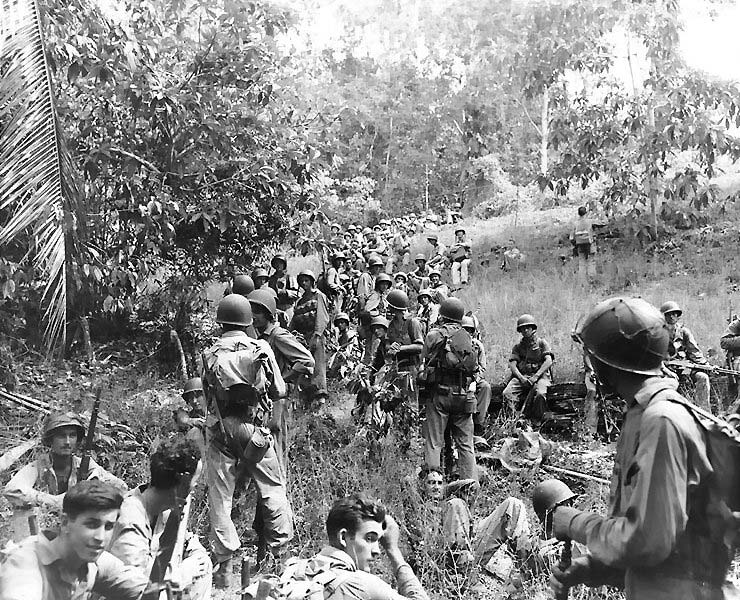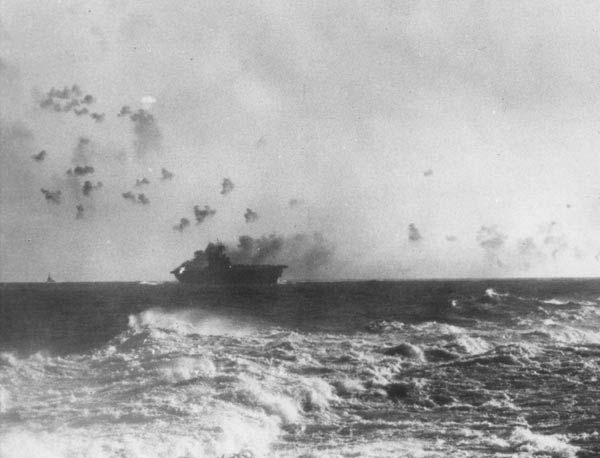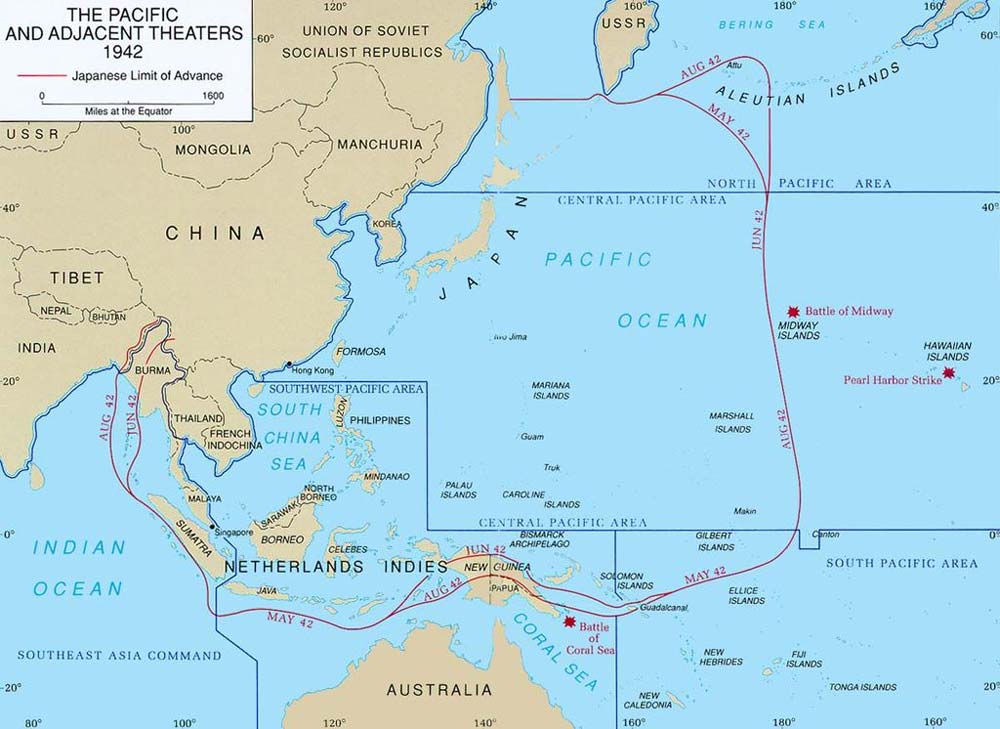| Guadalcanal Campaign | |||||||
|---|---|---|---|---|---|---|---|
 |
|||||||
|
|||||||
| Contenders | |||||||
| Military Leaders | |||||||
| Unit Strength | |||||||
| 60,000 men (ground troops) | 36,200 men (ground troops) | ||||||
| Casualties and Deaths | |||||||
| 7,100 dead 4 captured 29 ships lost 615 aircraft lost |
31,000 dead 1,000 captured 38 ships lost 683–880 aircraft lost |
||||||
| Part of World War II | |||||||
The Guadalcanal Campaign which was code-named as Operation Watchtower by the allied powers was a naval campaign that took place between August 7, 1942 and February 9, 1943. This campaign was the first major offensive that the allied powers initiated against Japan in WWII since the attack on Pearl Harbor in 1941. The campaign took place on and around the Guadalcanal Island in the Pacific Theater.
Location
The battle was fought in the Guadalcanal Island a mountainous island located in the Southwest pacific which is the largest of the Solomon Islands. It is a humid and tropical forest covered island whose position was of strategic importance to both parties in the Pacific war. This was because if the Empire of Japan captured the island, they would be able to terminate the sea route between America and Australia.
Equally, if the U.S. controlled the area, they would be in a better position to protect Australia against Japanese invasion. They would also be able to protect the Allied occupation in Australia which would serve as a catalyst for a major assault on the Empire of Japan.
The Campaign
This battle was fought with the air force, marines, and navy. The allied armies consisted of up to sixty thousand men. The commanders of the armies involved on the Allies side were Major General Alexander Vandergrift and Major General Alexander Patch. On the Japanese side, the armies were under the leadership of Lieutenant General Harukichi Hyakutake and General Hitoshi Imamura. Japan’s army involved in the campaign consisted of up to 36,200 men. The Japanese side used the Island of Guadalcanal as their airbase.
 The Allied powers mainly consisted of troops from America. They kicked off the landings on the Islands of Gavutu Tanambogo, Tulagi and Guadalcanal. The commander in chief of the American Fleet Admiral Ernest King called for the troops to land in the islands in order to protect the communication lines of the allied forces to Australia thus, allowing for the capture of a Japanese air base which was being constructed at Lunga point in Guadalcanal.
The Allied powers mainly consisted of troops from America. They kicked off the landings on the Islands of Gavutu Tanambogo, Tulagi and Guadalcanal. The commander in chief of the American Fleet Admiral Ernest King called for the troops to land in the islands in order to protect the communication lines of the allied forces to Australia thus, allowing for the capture of a Japanese air base which was being constructed at Lunga point in Guadalcanal.
In the period lasting between August 1942 to February 1943, America and its Pacific allies engaged in a brutal air-sea-land war against Japan for the control of the Island of Guadalcanal. Initially, Japan maintained a huge level of naval supremacy in the Pacific region. Nonetheless, the American first marine division landed in August 7th and seized an almost complete airfield that Japan was building at Lunga point and an anchorage at neighboring Tulagi. The battle ashore went on successfully and the initial aerial responses from Japan were costly and unfruitful.
Two days after the landings, Australian and American forces were defeated in the Battle of Savo Island. A long struggle ensued with its key focus on the Lunga Point airfield which was later named the Henderson Field. A Japanese ground force consisting of around six thousand troops attempted to storm the airfield on august 18th and recapture it, which they failed.
 In the resulting engagement the warring sides suffered several losses of their warships which were an extremely costly surface engagement. However, America succeeded in thwarting the attempts by Japan to attack Henderson Field with battleships. The Pacific Allies aircraft also sank a majority of Japan’s troop transports and barred them from reaching Guadalcanal. Consequently, the campaign turned the Empire of Japan last major trial to remove the Allied forces from the Island resulting into a major victory for the United States and its Allies, officially ending the battle of Guadalcanal.
In the resulting engagement the warring sides suffered several losses of their warships which were an extremely costly surface engagement. However, America succeeded in thwarting the attempts by Japan to attack Henderson Field with battleships. The Pacific Allies aircraft also sank a majority of Japan’s troop transports and barred them from reaching Guadalcanal. Consequently, the campaign turned the Empire of Japan last major trial to remove the Allied forces from the Island resulting into a major victory for the United States and its Allies, officially ending the battle of Guadalcanal.
The Battle Aftermath
The American Navy suffered such high personnel losses during the battle that it refused to publicly disclose the total casualty numbers for many years. As the campaign continued, American public became aware of the plight and recognized heroism of their forces on the Island. There was further dispatch of personnel which spelled disaster for Japan, since it was unable to match the American resources.
All in all both sides of the war suffered huge losses to their manpower and resources. During the battle, the Allied forces suffered major losses of about 7,100 men, 625 aircraft and 29 battleships. The Japanese losses, on the other hand, were 31,000 soldiers, 38 battle ships and, about 683 to 880 aircraft. With the victory of the battle, the strategic initiative was passed on to the Allies for the rest of the war period. Subsequently, the island was developed into a strategic base for supporting future Allied offensives.
The campaign proved to be costly to Japan materially and strategically. The strain on its resources hugely contributed to its failure to achieve its goals in the New Guinea Campaign. This exhaustion led to the successful conclusion of Allied campaigns of New Guinea. It was the first sustained campaign of the Allies in the Pacific which gave a psychological boost to the troops and also led to the establishment of combat and logistical systems to be used in the Allies’ march across the Pacific.
With the Island secured from Japan, operations proceeded in New Guinea, and the Allies’ commenced their Island hoping campaign towards Japan. Another loss for Japan was the loss of control of the Southern Solomon’s and also its ability to intercept Allied shipping to Australia.
Significance of the Battle of Guadalcanal
This was the first battle ever in the major campaign of America to free the Pacific from Japanese occupation. Even though the naval campaigns of the Coral Sea and Midway have been said to be the turning points in the Pacific war, this was the battle where Japan was finally stopped. This long lasting pacific war was fought by the American and Japanese forces in the farthest ends of their respective supply lines in a region where the climate and landscape was harsh to both. The victory of the Unites States at the island of Guadalcanal ensured the safety of Australia against future Japanese invasion. It also secured the sea route from Australia to America. The battling sides lost so many ships off the island that it was referred to as the Iron Bottom sound. As you can tell most of the battle’s burden was shouldered by the Navy of the United States and the Marine Corps. This was a battle that is well known for the key role it played in the second war as it turned the tide in favor of the Allies in the Pacific theater.